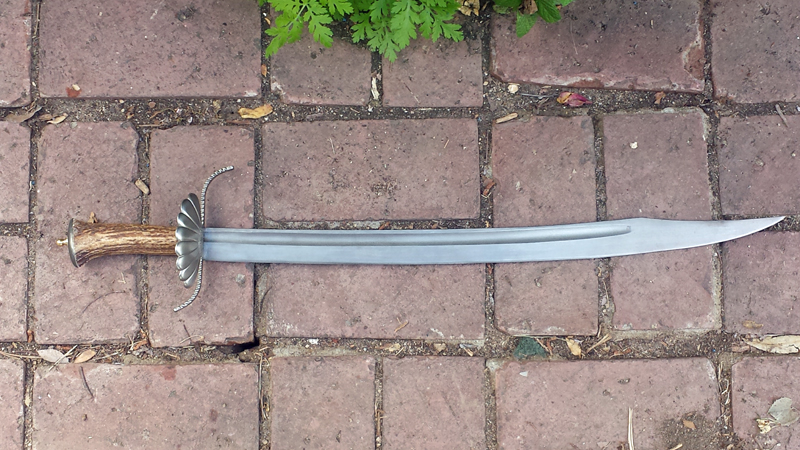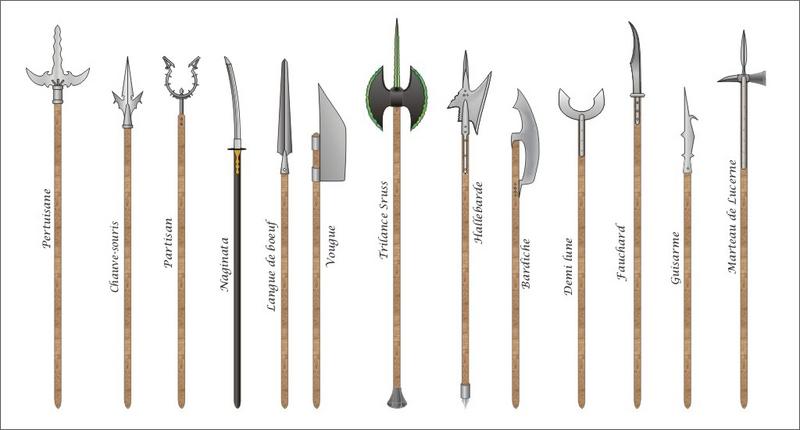|
|
Post by kemp on Aug 10, 2018 9:05:32 GMT -5
The Frontier kit.  |
|
|
|
Post by kemp on Aug 10, 2018 9:10:08 GMT -5
Colonial Hanger by Ben Potter  |
|
|
|
Post by zaskar24 on Aug 10, 2018 10:05:12 GMT -5
I would love to have reproductions of Hawkeye's knife and tomahawk from Last of the Mohicans. I have not looked at Daniel Winkler's site in quite awhile and am not even sure if he is still doing these. The last time I was there he was concentrating on tactical tomahawks. The Frontier kit.  |
|
|
|
Post by kemp on Aug 11, 2018 9:00:55 GMT -5
I would love to have reproductions of Hawkeye's knife and tomahawk from Last of the Mohicans. I have not looked at Daniel Winkler's site in quite awhile and am not even sure if he is still doing these. The last time I was there he was concentrating on tactical tomahawks. The Frontier kit.  Mostly tactical knives and axes these days. |
|
|
|
Post by Char-Vell on Aug 31, 2018 7:14:40 GMT -5
Historically, how often were swords actually used in combat, and what was the lifespan of a "working" sword?
|
|
|
|
Post by kemp on Aug 31, 2018 13:23:32 GMT -5
Historically, how often were swords actually used in combat, and what was the lifespan of a "working" sword? Swords were favoured weapons, versatile, but by no means solely used as the primary weapon in close combat in every situation, often a secondary weapon against Knights in armour where battle axes, maces and hammers were more effective against plate . Swords also had trouble getting through good mail armour and thick cloth armour, although sometimes the damage done to the opponent was by way of blunt trauma. Of course various sword designs were better suited for thrusting or cutting, stabbing into the gaps of armour, or as general cleaving weapons against lightly armoured opponents. Spear and pole arms/axes were more common amongst the general populace for much of the middle ages. The sword used by the Samurai was a last ditch weapon in the melee of battle, spears gave them a longer reach and Samurai excelled as mounted bowman. Medieval English longbow archers were armed with swords since they also fought as light infantry. Certainly swords were popular duelling weapons and status symbols, perhaps not the main battlefield weapons, although used by some soldiers as a primary close combat weapon. Swords were expensive to make for much of history, required some skill to use, certainly easier in many cases to equip the common infantry with spears as the fighting weapon of choice, especially in the early middle ages, say pre 1300, when swords could not be mass produced. Swords are versatile weapons, not the best for every combat job, but on hand when you lost your spear or polearm.  |
|
|
|
Post by kemp on Aug 31, 2018 13:33:11 GMT -5
As for the ‘lifespan’ of the working sword. Probably depended on use, I have read about well made swords, used skillfully, sharpened many times, and survived a century or two of use, passed down, but some of these might have been used sparingly, longswords used intensively for modern sparring have several years in them ( not just the blade, but handle coming apart ). Used against steel armour and heavy weapons they can get chewed up pretty quickly. Taken care of, a well made sword, periodically cleaned and sharpened, kept free of rust, and used on intended targets will last generations. I had a Generation 2 sword, made of spring steel, lasted years against light back yard cutting targets, the old plastic water bottles, shrub, branches etc, but when I had hit some thick steel plating, well, that gave a shit of a dent, sharpened it out, but it was deep enough to leave a nice notch. Again, the sword should only be used for what it was designed for. Having said that, in a real battle you would not be stopping to cry about dents and notches on your nice sword. You would be fighting to stay alive. :No animals or people were hurt in my backyard ‘melee’.  |
|
|
|
Post by kemp on Sept 1, 2018 8:53:36 GMT -5
I tossed up whether I should post this here or not. Some time back I had ground out a basic Bowie preform shape from an old file. It was given to someone who wanted to practise forging. With the preform already ground out all they had to do was forge in the bevels to create the blade before it was heat treated and finished. I emailed them this article by Chris Amos from Blade Magazine. I include the link here for information purposes. 'Make a Bowie Knife in 10 Steps' blademag.com/knifemaking/how-to-make-a-bowie-knife |
|
|
|
Post by kemp on Sept 1, 2018 8:57:22 GMT -5
The Bowie in the article was made by stock removal with no forging, but many of the steps can also be utilised in a forged blade, especially the clean up grinding/filing.
|
|
|
|
Post by kemp on Sept 5, 2018 8:49:39 GMT -5
It is amazing. I have recently started looking at some of the oldest weapons and tools made of iron and steel and was drawn to this iron dagger created centuries before the official start of the Iron Age, crafted from meteorite iron around 1350 BC. 'Daggers, axes and jewelry made from rare iron during the Bronze Age are literally out of this world, according to new research finding that ancient artisans crafted these metal artifacts with iron from outer space carried to Earth by meteorites. The finding upends the idea that a few artisans during the Bronze Age in the ancient Near East knew how to make iron by smelting it from Earth's crust. Instead, it appears that Bronze Age metalworkers sought out meteorites to make these treasures, said study author Albert Jambon, a French archaeo-metallurgist and a professor at the Pierre and Marie Curie University, in Paris. Jambon used a portable XRF analyzer to scan other ancient iron objects and iron meteorites in museums, as well as iron in private collections in Europe and the Middle East. His research showed that all the iron in the tested artifacts came from meteorites, and not from terrestrial smelting, he told Live Science in an email. The findings suggested that iron meteorites were the only source of that metal until the discovery of smelting iron from terrestrial iron ore, probably in Anatolia and the Caucasus around 3,200 years ago, Jambon said.' www.livescience.com/61214-king-tut-dagger-outer-space.html'Jambon examined some of the most ancient iron objects ever found, including sheet-iron beads from Gerzeh in Egypt, dated to 3200 B.C.; an ax from Ugarit on the coast of northern Syria, dated to 1400 B.C.; a dagger from Alaça Höyük in Turkey, dated to 2500 B.C.; and three iron objects from Tutankhamun's tomb, dated to 1350 B.C. — a dagger, a bracelet and a headrest.' 'This iron dagger from dagger from Alaça Höyük in Turkey is dated to 2500 B.C. — about 1,000 years before iron smelting was invented.'  |
|
|
|
Post by kemp on Sept 8, 2018 6:04:21 GMT -5
I had a bit of a search for the oldest steel swords that have been found and documented and came across this.  This sword from Jericho dates to about 600 BC and is on display in the Israel Museum. It is perhaps one of the most significant archaeological swords ever found. It hasn’t survived in the best condition, but here is a 3D model reconstruction of the Vered Jericho Sword.  <iframe width="22.720000000000027" height="3.8799999999999955" style="position: absolute; width: 22.72px; height: 3.88px; z-index: -9999; border-style: none; left: 5px; top: 37px;" id="MoatPxIOPT0_83757533" scrolling="no"></iframe> <iframe width="22.720000000000027" height="3.8799999999999955" style="position: absolute; width: 22.72px; height: 3.88px; z-index: -9999; border-style: none; left: 1067px; top: 37px;" id="MoatPxIOPT0_84491473" scrolling="no"></iframe> <iframe width="22.720000000000027" height="3.8799999999999955" style="position: absolute; width: 22.72px; height: 3.88px; z-index: -9999; border-style: none; left: 5px; top: 176px;" id="MoatPxIOPT0_24654015" scrolling="no"></iframe> <iframe width="22.720000000000027" height="3.8799999999999955" style="position: absolute; width: 22.72px; height: 3.88px; z-index: -9999; border-style: none; left: 1067px; top: 176px;" id="MoatPxIOPT0_22200813" scrolling="no"></iframe> |
|
|
|
Post by kemp on Sept 8, 2018 6:09:01 GMT -5
Excerpt from the Israel Museum Journal of 1992:
‘Microradiographic x-ray examination and photography of the sword indicate that the hilt, ridge, and the blade were prepared separately and then forged together by hammering. Metallurgical analysis of a sample taken from the blade proves that it was made of mild steel, and that the iron was deliberately hardened into steel, attesting to the technical knowledge of the blacksmith.
Here is the description of the sword as displayed in Jerusalem’s Israel Museum, Iron Age Gallery:
This rare and exceptionally long sword, which was discovered on the floor of a building next to the skeleton of a man, dates to the end of the First Temple period. The sword is 1.05 meters long and has a double edged blade, with a prominent central ridge running along its entire length.
The hilt was originally inlaid with a material that has not survived, most probably wood. Only the nails that once secured the inlays to the hilt can still be seen. The sword’s sheath was also made of wood, and all that remains of it is its bronze tip. Owing to the length and weight of the sword, it was probably necessary to hold it with two hands. The sword is made of iron hardened into steel, attesting to substantial metallurgical know-how. Over the years, it has become cracked, due to corrosion." (Biblical Archaeology Review 12/4 [July-August 1986]: 33, 35)’
What is also remarkable is that this is no short sword ( often associated with the first early steel swords ), the blade alone just shy of 3 feet in length. Ancient swords such as this find might have influenced later designs, the double edged cut and thrust sword that started out in the near east and eventually was adopted in various forms in other parts of Asia, Africa and Europe.
|
|
|
|
Post by kemp on Sept 8, 2018 6:25:38 GMT -5
Early Iron Swords Hittite iron sword dated to 1300 - 1400 BC.  |
|
|
|
Post by kemp on Sept 8, 2018 6:32:15 GMT -5
Early Mediterranean Swords  'No. 1 is from Saruq al-Hadid, a place way down on the Southern Dubai coast and described in a poster 1). It's age is somewhat vaguely given as 1200 BC - 300 BC. While found 800 km or so south-east of Luristan, the sword (and a lot of other iron artifacts found there) are believed to have their origin in Luristan, suggested by involved analysis of trace elements.' No 2 has been covered, the Vered Jericho sword 600 BC. 'No. 3 is a sword that is presently (Jan, 2017) on sale by Zurquieh Co. LLC, based in Dubai. It is described as "ancient Luristan iron sword from 1200 BC - 700 BC. It looks a lot like No. 1 and we might confidently assume that it comes "somehow" from Saruq al-Hadid, too.' |
|
|
|
Post by kemp on Sept 8, 2018 6:40:03 GMT -5
|
|